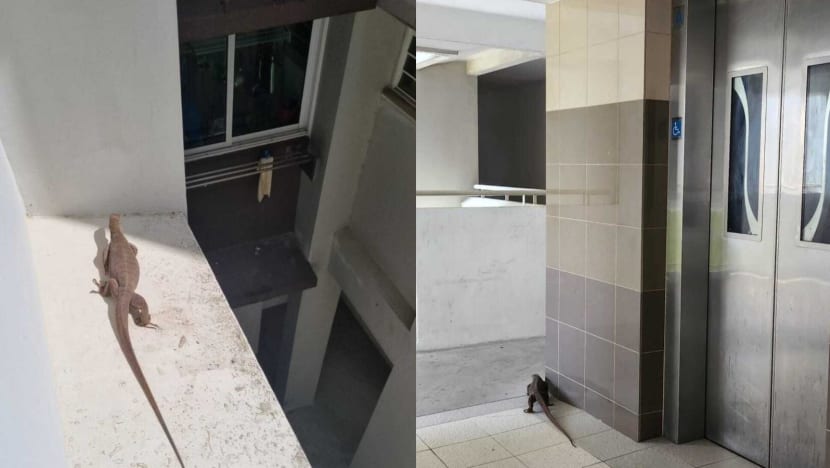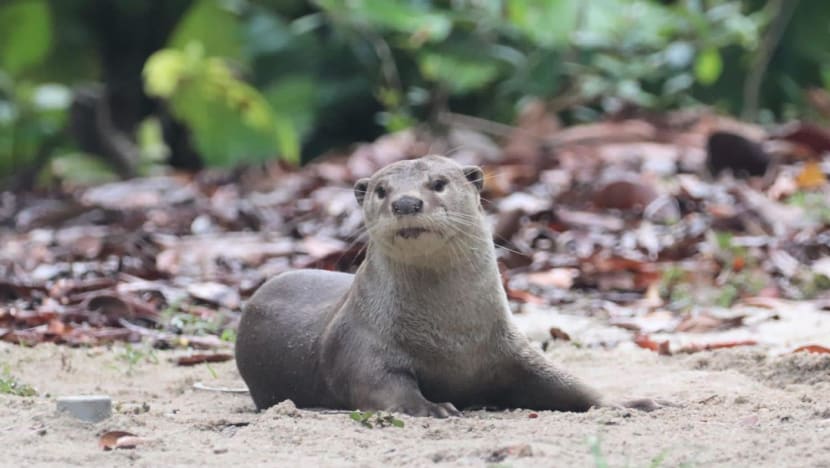Commentary: Why do monitor lizards inspire fear, but not otters?
Pythons and monitor lizards have provoked strong reactions from the people who encountered them in Singapore. This fear stems from our isolation from them, says Herpetological Society of Singapore’s Sankar Ananthanarayanan.

SINGAPORE: Some months ago, I visited a school to give a talk about the reptiles and amphibians of Singapore. The students were very engaged, and excited to hear about these strange creatures that were only a stone’s throw away from them.
All in all it went well, and I loved every moment of it.
The following day, I received a polite email from a concerned member of staff, thanking me for the presentation, but advising me to include a content warning at the start of my talk. After all, not everyone is comfortable seeing pictures of snakes, lizards, and frogs!
Understandably, I was confused. My talk was aimed at teaching students about Singapore’s native wildlife, encouraging them to treat these animals with respect, even if they didn’t find them aesthetically pleasing. Wouldn’t putting a content warning at the front of it, thereby marking these animals as “scary”, defeat the purpose of the talk?
LIVING ALONGSIDE REPTILES AND AMPHIBIANS
Singapore is home to almost 70 species of snakes, over 30 species of lizards, 29 species of frogs; not to forget several turtles and the saltwater crocodile. This diversity is comparable to countries many times larger than Singapore.
It’s no wonder that reptiles and amphibians are a common sight. The reticulated python, the longest snake in the world, is commonly encountered in our storm drains, canals, and even in public housing estates.
One such python met an unfortunate and gruesome end in Boon Lay in April. It was cruelly beaten and then beheaded with a cleaver amidst a crowd of cheering men.
While such animal abuse is abhorrent, it is hardly the first case of human-wildlife conflict, or interaction, in Singapore. Just over a month later, a Malayan water monitor found its way into the corridor of an HDB flat in Bedok North. Thankfully, this lizard was relocated by East Coast Town Council and National Parks Board without incident.
These occurrences are reflective of Singapore’s changing landscape. Pythons, monitor lizards, and many other herpetofauna were historically found all over the island. As urban development shrinks and degrades our island's natural habitats, these animals venture to built-up areas in search of food.
Reptiles like pythons, cobras and monitor lizards are very timid creatures that usually only strike in self-defence. Snakebites are relatively rare in Singapore, and there are no reports of deaths caused by them since 1995.
Yet, a 2019 YouGov survey of 1,033 Singaporeans found that “reptiles” was the third most reported fear (more than “public speaking”, “ghosts”, or even “death”). Where does this collective fear for these animals come from?
NATURAL TO BE AFRAID OF CERTAIN ANIMALS
This question rang in my head as I considered putting a content warning for my talk. I brought this question to some peers, who run other programmes educating the public about insects and other creepy-crawlies (a term that, as I type it, I realise reinforces negative stereotypes about these beautiful animals).
After a robust discussion, I gained a new way of looking at my dilemma. It is not fair to expect my audience to start at the same place as me, and to impose the acceptance of these animals on a naive population.
Reptiles and insects have evolved alongside us such that their defence mechanisms trigger our natural flight responses. Think of a cobra spreading its hood, or a brightly coloured wasp. It is perfectly natural to be afraid of these cues and react accordingly.
As a communicator, I need to meet my audience where they are, validate their fears, and try to bridge that gap.
In truth, our collective fear of these animals stems from our isolation from them. Urban Singapore is, at least cognitively, very separate from the forests of Singapore. Over time, people have become socialised into expecting to see wildlife only at the zoo, or maybe while hiking in a green space, but certainly not at our doorsteps.
Unfortunately, this is an unreasonable expectation. In a small city-state, with increasing pressures on natural spaces, the remaining wildlife cannot be restricted to our shrinking forests. It is almost inevitable that such encounters will occur.
BIAS FOR CUDDLY ANIMALS
There is also an intrinsic prejudice against animals that are less like us. The sight of a monitor lizard or a nest of wasps is enough to have some people break out in a cold sweat. Yet otters, which are capable of causing serious injury to people, elicit delight and curiosity when encountered in public.
This is not to villainise otters, but to raise the question - why do we treat some animals differently than others? Should we not value all native wildlife?
This is a well-documented bias, where people show more affinity towards animals that are perceived as large, furry and cuddly. This bias can impact research funding, policymaking, and how we treat these animals.
MAINSTREAMING NATIVE BIODIVERSITY

So, where do we go from here?
Local biodiversity needs to be made an intrinsic aspect of the education system. Beyond teaching students about the diversity of wildlife in the country and region, civics and moral education classes can incorporate respect for animals and their habitats. These changes can drive a shift in how a new generation feels about and responds to wildlife encounters.
In the last few years, many new nature parks have been added to Singapore’s already impressive repertoire. Singapore aims to have every household within a 10-minute walk of a park by 2030.
This is encouraging as Singapore continues to build up its urban landscape. The presence of green spaces will mainstream native biodiversity, and enhance our appreciation and acceptance of our wild neighbours.
Simultaneously, we must prioritise the protection and preservation of our remaining forests, to ensure these animals have space to thrive.
Personally, I’ll continue to give school talks wherever I can, though I will give the audience a heads-up about what to expect. Maybe we will meet halfway.
Sankar Ananthanarayanan is co-founder of the Herpetological Society Singapore.









